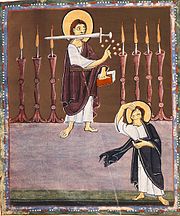Son of man

"Son of man" is a phrase used in the Hebrew Bible, various apocalyptic works of the intertestamental period, and in the Greek New Testament. In the indefinite form ("son of man", "one like a son of man") used in the Hebrew Bible and intertestamental literature it is a form of address, or contrasts human beings against God, or signifies an eschatological figure due to come at the end of history. The New Testament uses the earlier indefinite form while introducing a novel definite form, "the son of man."
History
Old Testament
The Hebrew expression "son of man" (בן–אדם, ben-'adam) appears 107 times in the Hebrew Bible, the majority (93 times) in the Book of Ezekiel.[1] It is used in three main ways: as a form of address (Ezekiel); to contrast the lowly status of humanity against the permanence and exulted dignity of God and the angels (Book of Numbers 23:19, Psalm 8:4); and as a future eschatological figure whose coming will signal the end of history and the time of God's judgement (Daniel 8:17).[2]
In the book of Daniel, chapter 7 tells of a vision given to the prophet Daniel in which four "beasts," representing pagan nations, oppress the people of Israel until judged by God. Daniel 7:13-14 describes how the "Ancient of Days" (God) gives dominion over the earth to "one like a son of man," who is later explained as standing for "the saints of the Most High" (7:18, 21-22) and "the people of the saints of the Most High" (7:27).[3] The "saints" and "people of the saints" in turn probably stand for the people of Israel – the author is expressing the hope that God will take dominion over the world away from the beast-like "nations" and give it human-like Israel.[3]
Apocrypha and Pseudepigrapha
While Daniel 7:13 "like a son of man" probably did not stand for the Messiah, where the phrase appears in extant versions of later apocryphal and deuterocanonical works such as the Similitudes of Enoch and 4 Ezra gave it this interpretation.[3] Whether these messianic "Son of Man" references are genuinely Jewish or the result of Christian interpolation is disputed.[4] An example of a disputed section is that of The Similitudes (1 Enoch 37-71) which uses Daniel 7 to produce an unparalleled messianic Son of Man, pre-existent and hidden yet ultimately revealed, functioning as judge, vindicator of righteousness, and universal ruler.[5] The Enochic messianic figure is an individual representing a group, (the Righteous One who represents the righteous, the Elect One representing the elect), but in 4 Ezra 13 (also called 2 Esdras) he becomes an individual man.[6][7][8]
New Testament
The New Testament features the indefinite "a son of man" in Hebrews 2:6 (citing psalm 8:4), and "one like a son of man" in Revelation 1:13 and 14:14 (referencing Daniel 7:13's "one like a son of man").[9] The four gospels introduce a new definite form, "ὁ υἱὸς τοὺ ἀνθρώπου", literally "the man's son." It is awkward and ambiguous in Greek.[1] In all four it is used only by Jesus (except once in the Gospel of John, when the crowd asks what Jesus means by it), and functions as an emphatic equivalent of the first-person pronoun, I/me/my.[10] German theologian Rudolf Bultmann sees the phrase not as one genuinely used by Jesus but as one inserted by the early Church.[11]
See also
- The Son of Man, René Magritte painting, 1946
Footnotes
- ^ a b Bromiley 1995, p. 574.
- ^ McGrath 2011, p. 270.
- ^ a b c Burkett 2002, p. 64.
- ^ G. Nickelsburg, “Son of Man.“ in Anchor Bible Dictionary 6.138.
- ^ Bromiley 1995, p. 575.
- ^ Slater 1999, p. 71.
- ^ The Expository Times 1900 - Volume 11 - Page 64 "Again, Schmiedel is quite prepared to admit the possibility that the Son of man passages in Enoch may be Christian interpolation, and so far as ability to deal with this part of the problem depends on a knowledge of Ethiopic (in which language ..."
- ^ The Enoch-Metatron Tradition - Page 82 3161485440 Andrei A. Orlov - 2005 "The same interchangeability is observable in the titles “son of man“ and “chosen one.” Here ... 88 Some scholars believe that these chapters might represent later interpolation(s) and do not '83 G. Nickelsburg, “Son of Man.“ ABD 6.138."
- ^ Hurtado 2005, p. 293 fn.83.
- ^ Hurtado 2005, p. 290, 292, 293.
- ^ Burkett 2000, p. 121,124.
References
- Bromiley, Geoffrey W. (1995). International Standard Bible Encyclopedia: vol. iv, Q-Z. Eerdmans.
{{cite book}}: Invalid|ref=harv(help) - Budd, Philip J. (2003). "Numbers". In Dunn, James D. G.; Rogerson, John William (eds.). Eerdmans Commentary on the Bible. Eerdmans. ISBN 9780802837110.
{{cite book}}: Invalid|ref=harv(help) - Burkett, Delbert (2002). An Introduction to the New Testament and the Origins of Christianity. Cambridge University Press.
{{cite book}}: Invalid|ref=harv(help) - Burkett, Delbert (2000). The Son of Man Debate: A History and Evaluation. Cambridge University Press.
{{cite book}}: Invalid|ref=harv(help) - Collins, John J. (1984). Daniel: With an Introduction to Apocalyptic Literature. Eerdmans.
{{cite book}}: Invalid|ref=harv(help) - Higgins, A.J.B. (2002). Jesus and the Son of Man. James Clarke & Co.
{{cite book}}: Invalid|ref=harv(help) - Hurtado, Larry W. (2005). Lord Jesus Christ: Devotion to Jesus in Earliest Christianity. Eerdmans.
{{cite book}}: Invalid|ref=harv(help) - McGrath, Alister E. (2011). Christian Theology: An Introduction. John Wiley & Sons.
{{cite book}}: Invalid|ref=harv(help) - Slater, Thomas (1999). Christ and Community: A Socio-Historical Study of the Christology of Revelation. A&C Black.
{{cite book}}: Invalid|ref=harv(help)
